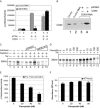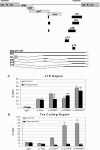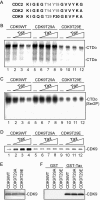Tax interacts with P-TEFb in a novel manner to stimulate human T-lymphotropic virus type 1 transcription
- PMID: 16641271
- PMCID: PMC1472077
- DOI: 10.1128/JVI.80.10.4781-4791.2006
Tax interacts with P-TEFb in a novel manner to stimulate human T-lymphotropic virus type 1 transcription
Abstract
Human T-lymphotropic virus type 1 (HTLV-1) encodes a transcriptional activator, Tax, whose function is essential for viral transcription and replication. Tax transactivates the viral long-terminal repeat through a series of protein-protein interactions which facilitate CREB and CBP/p300 binding. In addition, Tax dissociates transcription repressor histone deacetylase 1 interaction with the CREB response element. The subsequent events through which Tax interacts and communicates with RNA polymerase II and cyclin-dependent kinases (CDKs) are not clearly understood. Here we present evidence that Tax recruits positive transcription elongation factor b (P-TEFb) (CDK9/cyclin T1) to the viral promoter. This recruitment likely involves protein-protein interactions since Tax associates with P-TEFb in vitro as demonstrated by glutathione S-transferase fusion protein pull-down assays and in vivo as shown by co-immunoprecipitation assays. Functionally, small interfering RNA directed toward CDK9 inhibited Tax transactivation in transient assays. Consistent with these findings, the depletion of CDK9 from nuclear extracts inhibited Tax transactivation in vitro. Reconstitution of the reaction with wild-type P-TEFb, but not a kinase-dead mutant, recovered HTLV-1 transcription. Moreover, the addition of the CDK9 inhibitor flavopiridol blocked Tax transactivation in vitro and in vivo. Interestingly, we found that Tax regulates CDK9 kinase activity through a novel autophosphorylation pathway.
Figures







Similar articles
-
Human T-lymphotropic virus type 1 Tax protein complexes with P-TEFb and competes for Brd4 and 7SK snRNP/HEXIM1 binding.J Virol. 2010 Dec;84(24):12801-9. doi: 10.1128/JVI.00943-10. Epub 2010 Oct 6. J Virol. 2010. PMID: 20926576 Free PMC article.
-
Modulation of the Brd4/P-TEFb interaction by the human T-lymphotropic virus type 1 tax protein.J Virol. 2007 Oct;81(20):11179-86. doi: 10.1128/JVI.00408-07. Epub 2007 Aug 8. J Virol. 2007. PMID: 17686863 Free PMC article.
-
Tax relieves transcriptional repression by promoting histone deacetylase 1 release from the human T-cell leukemia virus type 1 long terminal repeat.J Virol. 2004 Jul;78(13):6735-43. doi: 10.1128/JVI.78.13.6735-6743.2004. J Virol. 2004. PMID: 15194748 Free PMC article.
-
Latency Reversing Agents: Kick and Kill of HTLV-1?Int J Mol Sci. 2021 May 24;22(11):5545. doi: 10.3390/ijms22115545. Int J Mol Sci. 2021. PMID: 34073995 Free PMC article. Review.
-
The emerging picture of CDK9/P-TEFb: more than 20 years of advances since PITALRE.Mol Biosyst. 2017 Jan 31;13(2):246-276. doi: 10.1039/c6mb00387g. Mol Biosyst. 2017. PMID: 27833949 Review.
Cited by
-
Characterization of new RNA polymerase III and RNA polymerase II transcriptional promoters in the Bovine Leukemia Virus genome.Sci Rep. 2016 Aug 22;6:31125. doi: 10.1038/srep31125. Sci Rep. 2016. PMID: 27545598 Free PMC article.
-
Cracking the control of RNA polymerase II elongation by 7SK snRNP and P-TEFb.Nucleic Acids Res. 2016 Sep 19;44(16):7527-39. doi: 10.1093/nar/gkw585. Epub 2016 Jul 1. Nucleic Acids Res. 2016. PMID: 27369380 Free PMC article. Review.
-
TFIID component TAF7 functionally interacts with both TFIIH and P-TEFb.Proc Natl Acad Sci U S A. 2008 Apr 8;105(14):5367-72. doi: 10.1073/pnas.0801637105. Epub 2008 Apr 7. Proc Natl Acad Sci U S A. 2008. PMID: 18391197 Free PMC article.
-
The HTLV-1 Tax interactome.Retrovirology. 2008 Aug 14;5:76. doi: 10.1186/1742-4690-5-76. Retrovirology. 2008. PMID: 18702816 Free PMC article. Review.
-
Regulation of CDK9 activity by phosphorylation and dephosphorylation.Biomed Res Int. 2014;2014:964964. doi: 10.1155/2014/964964. Epub 2014 Jan 12. Biomed Res Int. 2014. PMID: 24524087 Free PMC article. Review.
References
-
- Astier-Gin, T., J. P. Portail, F. Lafond, and B. Guillemain. 1995. Identification of HTLV-I- or HTLV-II-producing cells by cocultivation with BHK-21 cells stably transfected with a LTR-lacZ gene construct. J. Virol. Methods 51:19-29. - PubMed
-
- Bex, F., and R. B. Gaynor. 1998. Regulation of gene expression by HTLV-I Tax protein. Methods 16:83-94. - PubMed
MeSH terms
Substances
LinkOut - more resources
Full Text Sources
Other Literature Sources
Miscellaneous

